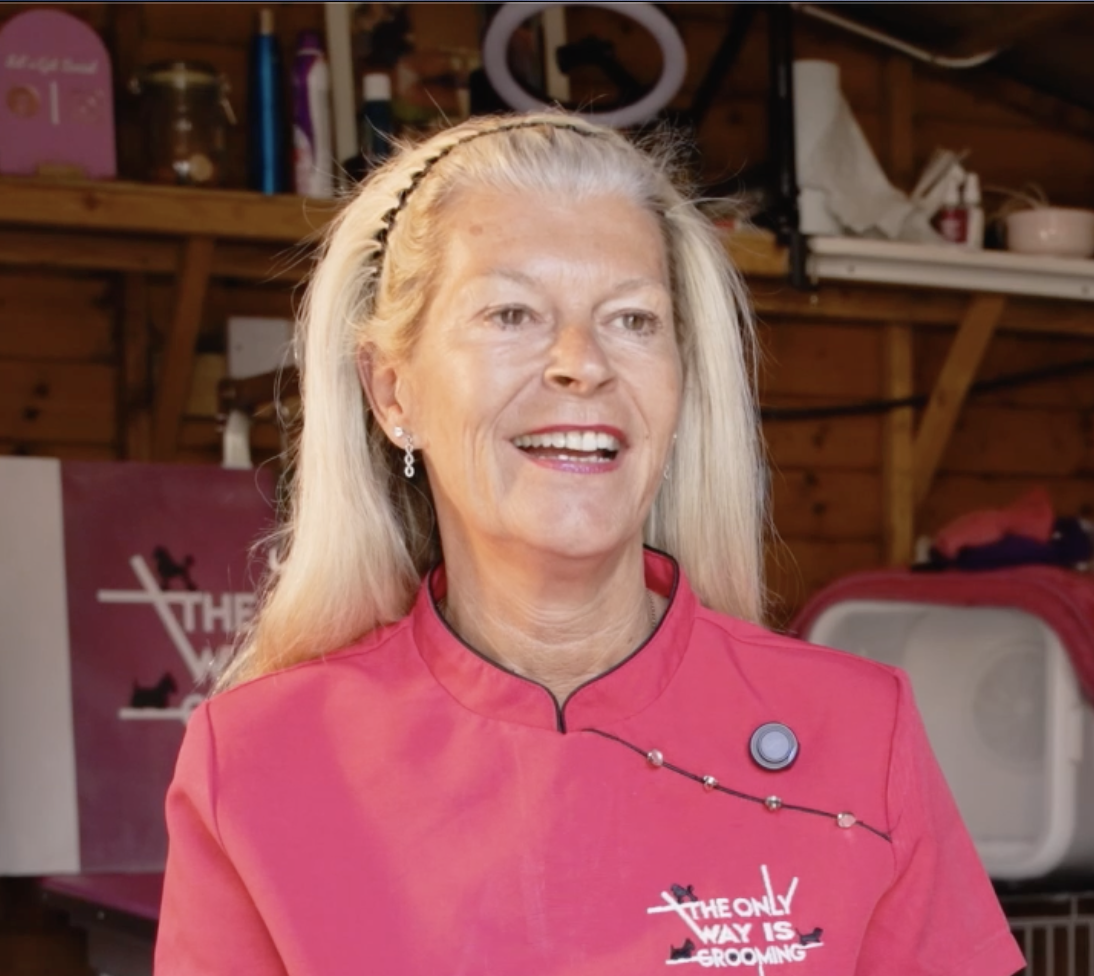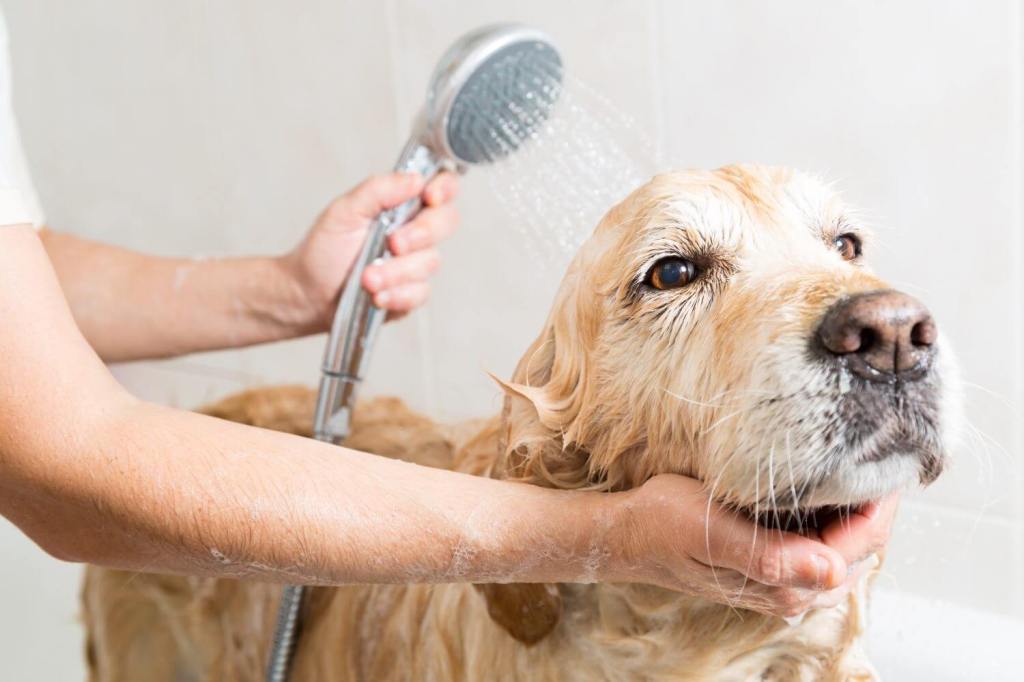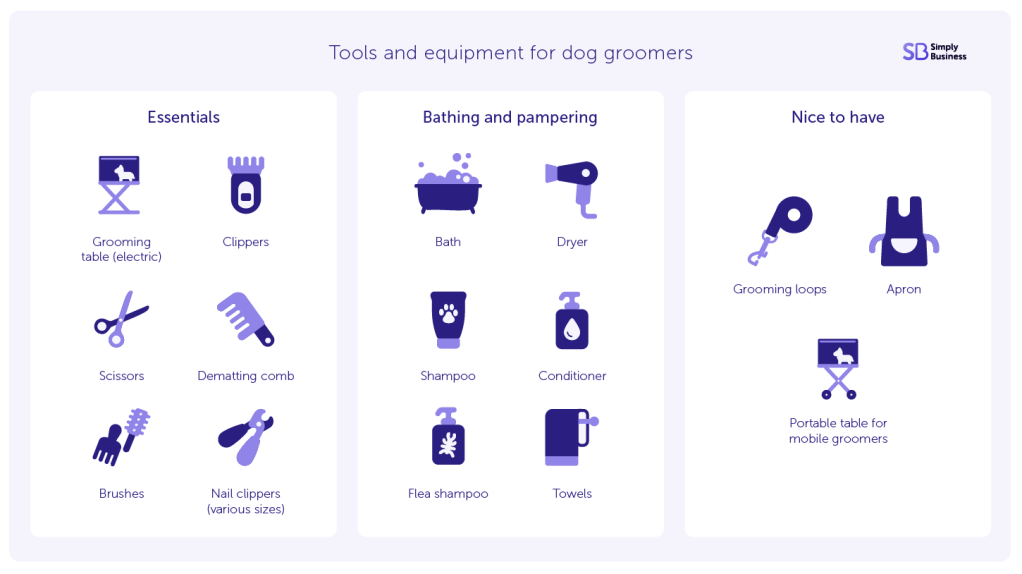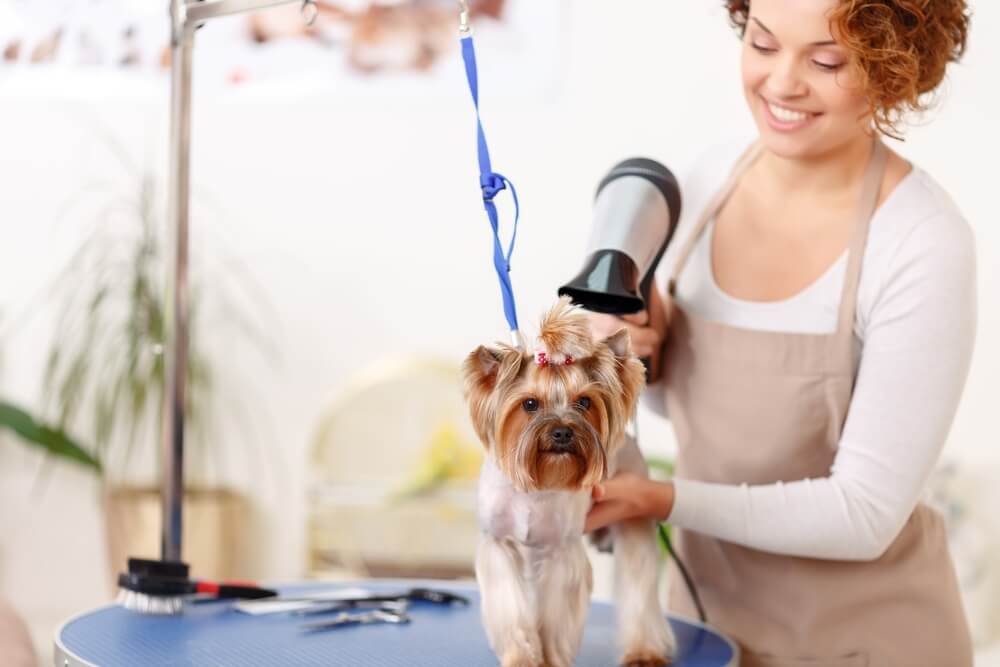Love dogs and dream of starting a dog grooming business? With 10.6 million pet dogs in the UK in 2024, there’s a growing demand for skilled, trusted dog groomers.
Kim started her dog grooming business, The Only Way is Grooming, after being made redundant at the age of 50. In this guide, she shares her tips on how to become a dog groomer, including tools and qualifications you need as well as how to manage bookings and cancellations.
Whether you want to set up a mobile dog grooming salon or work from home, our step-by-step guide will show you how to become a self-employed dog groomer.
Contents
- Get hands-on experience
- Weigh up the pros and cons
- Gain qualifications
- Create your business plan
- Choose a premises and budget accordingly
- Consider pet grooming insurance
- Check legal requirements
- Buy professional dog grooming equipment
- Set up your business and register as self-employed
- Use social media to your advantage
How to become a dog groomer
Dog groomers do exactly what it says on the tin. More specifically, this means bathing, brushing, and drying dogs, keeping their fur trimmed and their claws clipped.
They also give owners advice on grooming, diet, and coat care.
To become a professional dog groomer you’ll need a real love of animals, patience, and a calm temperament – you may need to calm nervous or unpredictable dogs.
You’ll also need good communication skills to deal with owners (your human clients) day to day, as well as creativity and business savvy to sell your service and build your customer base. What is it that makes pet owners want to spend money on their pets? How do you tap into that emotional desire?

“I operate on a one-to-one grooming basis and my attention is focused completely on your dog when it arrives for the groom. Lots of patience, lots of understanding, a break if necessary and a calm voice is essential.”
Kim
Founder of The Only Way is Grooming
Here’s how you can learn these skills and launch your own dog grooming business.
Step 1. Get hands-on experience
The best way to build your dog grooming CV is to volunteer at a kennel or become an apprentice at an established salon. Be prepared to be flexible as you get to know every aspect of running a salon, from understanding the behaviour of different breeds and their nutritional needs, to knowing which specific health problems to watch out for. With experience you can then consider going self-employed.
Practical learning to be a dog groomer
- Volunteering with dogs
- Job shadowing
- Dog grooming courses
- Apprenticeships at a salon
- Canine health and first aid
- Work experience
Step 2. Weigh up the pros and cons
Make sure that you’re fully committed to your business idea. You might love the idea of being around dogs, but are you prepared for the physical demands of the job? You’ll be on your feet all day, often dealing with stressed out dogs and demanding owners. Speak to some experienced dog groomers to make sure you’re fully aware of what the job entails.

Step 3. Gain dog grooming qualifications
Dog groomer qualifications aren’t essential, but completing a course related to animal care and maintenance can help you stand out to potential clients and employers.
There are a number of training routes available – college courses, apprenticeships, and specialist courses run by private organisations. How long it takes to become a dog groomer will depend on which you take.
These City & Guilds dog groomer training courses are offered at colleges and centres across the country:
- Level 2 Certificate for Dog Grooming Assistants
- Level 3 Certificate in Introductory Dog Grooming
- Level 3 Certificate/Diploma for Dog Grooming Stylists
You could complete a Dog Grooming Level 2 Apprenticeship, or even an Animal Care and Welfare Manager Level 3 Advanced Apprenticeship to help with supervising or managing other staff or your wider business.
Finally, the National Pet College has accredited some organisations to deliver professional training privately.
Whatever course you choose, make sure it offers dog models so you’ll always be able to practice grooming a real dog. Keep a portfolio of all your work so you can demonstrate your experience.
It’s always a good idea to continue your professional development once you’ve qualified, for example you could study:
- canine health and first aid
- canine oral care and dental hygiene
- specific breeds or grooming styles
Kim says she’s completed an Asian Fusion course, which is a popular grooming trend, as well as specific health and oral hygiene courses, and a webinar on cockapoos. She also recommends having a mentor in the early days of becoming a dog groomer.

“I had a mentor through my work experience. It’s always reassuring to hear another voice and opinion on any problems that you’ve got when you’re carrying out a groom.”
Kim
Founder of The Only Way is Grooming
Step 4. Create a business plan
It’s important to write your dog grooming business plan so you know how your business will be structured and marketed – but also how you expect it to grow.
Find your niche
You’ll need to identify what makes your business unique so you can stand out in a competitive market. Are you going to specialise in grooming small dogs or long haired dogs? Will you focus on running a sustainable business with eco-friendly products?
For example, Kim says her dog grooming business specialises in rescue dogs. She’s also done specific training on cockapoo grooming.
Research your competitors
It’s also useful to conduct competitor analysis to better understand the landscape you’re working in and how you can offer something different, better, or new compared to similar businesses in your area. You could even try visiting a few of your competitors as a customer if you or a friend has a dog.
Step 5. Choose a premises and budget accordingly
Consider if you want to offer mobile dog grooming or if you’ll rent a space in a salon. The cost will vary depending on where you decide to operate. Make sure you factor in rent and vehicle costs (where relevant) as well as the cost of your equipment.
Here are the pros and cons of different dog grooming business models:
| Business model | Pros | Cons |
| Mobile | Flexible, low rent | Vehicle costs, travel time |
| Salon | Professional look, footfall | Higher overheads |
| Home-based | Low setup cost | Limited client base |
Step 6. Consider pet grooming insurance
Running a dog grooming business involves caring for people’s pets, which means they expect you to operate in a professional and careful way.
Getting a tailored pet grooming insurance policy can protect you, your premises, and the dogs in your care, should something go wrong. Business insurance for dog groomers is designed to protect you in a range of situations, for example if you accidentally injure someone’s dog while clipping its nails.
Step 7. Check legal requirements
While no formal licence is required to become a dog groomer in the UK, you must comply with legal standards such as the Animal Welfare Act 2006. This includes making sure pets are safe, providing a clean environment and using safe grooming products.
- Animal Welfare Act 2006 – you have a duty of care to people’s pets so you must follow good practice, which includes providing the right environment and nutrition, and protecting dogs from pain or injury
- Copyright, Designs & Patents Act 1988 – if you’re planning to play music in your salon, make sure you organise a licence from PPL PRS
- Control of Substances Hazardous to Health (COSHH) – when using potentially harmful chemicals, for example shampoos and cleaning products, make sure you know how to keep yourself and your employees safe by using the correct protective equipment
Pet industry publishes new guidelines for groomers
New grooming guidance for professional dog and cat groomers was published in June 2025. Developed by the Canine and Feline Sector Group (CFSG) in partnership with the Pet Industry Federation (PIF) and the British Isles Grooming Association (BIGA), the best practice guidelines are designed to protect animal welfare and set professional standards.
Key themes include:
- Following the Animal Welfare Act 2006
- Minimising stress and anxiety in animals during grooming
- Keeping pets no longer than 3 hours unless licensed for daycare
- Ensuring hygiene, safe equipment, and clear handling procedures
- Holding relevant pet grooming qualifications and staying up to date with CPD
- Setting salon policies for cancellations, emergency plans, and coat condition management
Download the CFSG best practice guidelines.
Step 8. Buy professional dog grooming equipment
Generally speaking, you’ll need various grooming tools and products to get started.
Grooming essentials
- grooming table
- clippers
- scissors
- dematting comb
- brushes
- nail clippers (various sizes)
Bathing and pampering
- bath
- dryer
- shampoo
- conditioner
- flea shampoo
- towels
Nice to have
- apron
- grooming loops
- portable table for mobile groomers

Step 9. Register as a self-employed dog groomer
Everyone who’s self-employed must be registered with HMRC so you can declare your earnings and pay the correct tax. Unsure how to register and why? Our guide on setting yourself up as self-employed will help get you up to speed on the admin side of running your own business.
When setting up your grooming business, dog groomer Kim recommends:
- securing a premises (make sure you have electricity and hot and cold water available)
- expanding your offering beyond dog grooming to include grooms for cats, rabbits, and guinea pigs
- considering spa packages and oral health checks if you have the training
- using WhatsApp or text to confirm customer bookings immediately
- having clear payment terms and a cancellation policy
Step 10. Use social media to your advantage
Once you’ve launched your grooming business, you’ll need to find ways to stand out and attract new customers. Our guide to marketing has everything you need to consider, from branding and strategy to different ways to advertise your business.
Specifically for this industry, you might consider running or attending dog grooming competitions, events, and workshops to start building your profile. Treat these as opportunities to promote yourself and what you do, while also building a professional network as a dog groomer.
Marketing on social media can be a great way to reach potential customers – because who doesn’t love a cute dog picture on Instagram?

“Social media is really important for a groomer. You need to be putting yourself out there. It helps to get clients, it helps with likes, it helps with followers. And also you’re educating your clients about what’s going on behind the scenes when you’re grooming their dogs.”
Kim
Founder of The Only Way is Grooming
Asking for customer reviews can also help you to build a reputation and demonstrate your skills.
Kim shares: “It’s very rewarding, the satisfaction that it gives me once the dog has had its groom and left the salon – especially if the owner gives me a five-star review.”

FAQs
What is a dog groomer salary?
As a starting salary, dog groomers typically earn £13,000, and with experience this can rise to £20,000, according to the National Careers Service.
The good thing is, once you’re a self-employed dog groomer you can set your own prices. The UK average for a grooming session is now around £43.
The amount you charge will usually vary, depending on the size of the dog, condition of its coat, its temperament, and where your business is based.
How much should I charge as a self-employed dog groomer?
Pricing depends on the size of the dog, coat condition, and where you’re operating. If you live in a city then you’ll probably be able to charge more. Researching what similar businesses in your area charge for dog grooming services can give you a good idea of how much you can charge.
Can I run a dog grooming business from home?
You can run a dog grooming business from home but you may need to inform your local council or landlord. You’ll also need a safe, clean environment that meets animal welfare standards. It’s important that your premises has access to electricity as well as hot and cold water for grooming.
Read our in-depth guide to learn more about starting a business from home.
What insurance do dog groomers need?
Common policies for dog groomers include public liability insurance and employers’ liability insurance if you hire staff. Other covers you might choose include tools cover, stock insurance, and legal expenses cover.
Simply Business offers flexible pet grooming insurance for dog groomers, so you only pay for the cover you need.
Similar careers in the pet industry
There’s a range of careers in the pet industry for those who want to work with different animals. You could also consider becoming a:
- dog walker
- cattery owner
- pet minder (anything from cats and dogs to birds and horses)
Other small business guides:
- UK business ideas for 2025 – top trends to watch
- How to start your own business: a 9-step guide
- Self-assessment and tax resources
- Best business loans compared
Insure your dog grooming business
With Simply Business you can build a single self employed insurance policy combining the covers that are relevant to you. Whether it’s public liability insurance, professional indemnity or whatever else you need, we’ll run you a quick quote online, and let you decide if we’re a good fit.
